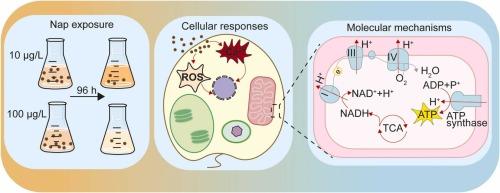有害藻华种赤藻对萘暴露的生理反应及适应机制
IF 11.3
1区 环境科学与生态学
Q1 ENGINEERING, ENVIRONMENTAL
引用次数: 0
摘要
多环芳烃(PAHs),尤其是萘烃(Nap),对沿海生态系统构成严重威胁,并可能导致有害藻华(HABs)的发生。然而,HAB 物种对 PAH 污染的反应机制仍不清楚。本研究调查了有害藻华物种 Heterosigma akashiwo 对不同浓度 Nap 的生理和分子反应。低浓度(1 - 10 μg/L)促进生长,而高浓度(20 - 1000 μg/L)则抑制生长,导致细胞形态异常和氧化应激。在 96 小时内,H. akashiwo 可清除 82.38% (10 μg/L)和 88.93% (100 μg/L)的 Nap,主要是通过生物降解和细胞内积累。转录组分析表明,H. akashiwo 采用了多方面的适应策略来应对 Nap 胁迫。主要机制包括上调钙信号、转录因子(如锌指蛋白 C2H2、骨髓母细胞病转录因子、碱性亮氨酸拉链转录因子)、热休克蛋白(如 HSP40)和脂肪酸去饱和酶(FAD),通过解毒、抗氧化反应和膜完整性增强应激耐受性。过氧化物酶体和氧化磷酸化基因的激活表明解毒和能量代谢得到改善。PI3K-Akt 通路基因的差异表达显示了剂量依赖性生长反应,低浓度促进增殖,高浓度抑制生长。这些发现深入揭示了 H. akashiwo 对那不勒斯的适应性反应,有助于生态风险评估和海洋环境中多环芳烃污染的生物修复策略。本文章由计算机程序翻译,如有差异,请以英文原文为准。

Physiological responses and adaptive mechanisms of the harmful algal bloom species Heterosigma akashiwo to naphthalene exposure
Polycyclic aromatic hydrocarbons (PAHs), especially naphthalene (Nap), pose a significant threat to coastal ecosystems and may contribute to the occurrence of harmful algal blooms (HABs). However, the response mechanisms of HAB species to PAH pollution remain unclear. This study investigated the physiological and molecular responses of the HAB species Heterosigma akashiwo to varying Nap concentrations. Low concentrations (1 - 10 μg/L) promoted growth, while high concentrations (20 - 1000 μg/L) inhibited growth, causing abnormal cell morphology and oxidative stress. Within 96 h, H. akashiwo removed 82.38% (10 μg/L) and 88.93% (100 μg/L) of Nap, mainly through biodegradation and intracellular accumulation. Transcriptomic analysis revealed that H. akashiwo employs a multifaceted adaptive strategy to cope with Nap stress. Key mechanisms include the upregulation of calcium signaling, transcription factors (e.g., zinc finger protein C2H2, myeloblastosis transcription factor, basic leucine zipper transcription factor), heat shock proteins (e.g., HSP40), and fatty acid desaturase (FAD), enhancing stress tolerance through detoxification, antioxidant responses, and membrane integrity. Activation of peroxisomal and oxidative phosphorylation genes indicates improved detoxification and energy metabolism. Differential expression of genes in the PI3K-Akt pathway reveals dose-dependent growth responses, with low concentrations promoting proliferation and high concentrations inhibiting growth. These findings offer insights into H. akashiwo’s adaptive responses to Nap, aiding ecological risk assessment and bioremediation strategies for PAH pollution in marine environments.
求助全文
通过发布文献求助,成功后即可免费获取论文全文。
去求助
来源期刊

Journal of Hazardous Materials
工程技术-工程:环境
CiteScore
25.40
自引率
5.90%
发文量
3059
审稿时长
58 days
期刊介绍:
The Journal of Hazardous Materials serves as a global platform for promoting cutting-edge research in the field of Environmental Science and Engineering. Our publication features a wide range of articles, including full-length research papers, review articles, and perspectives, with the aim of enhancing our understanding of the dangers and risks associated with various materials concerning public health and the environment. It is important to note that the term "environmental contaminants" refers specifically to substances that pose hazardous effects through contamination, while excluding those that do not have such impacts on the environment or human health. Moreover, we emphasize the distinction between wastes and hazardous materials in order to provide further clarity on the scope of the journal. We have a keen interest in exploring specific compounds and microbial agents that have adverse effects on the environment.
 求助内容:
求助内容: 应助结果提醒方式:
应助结果提醒方式:


